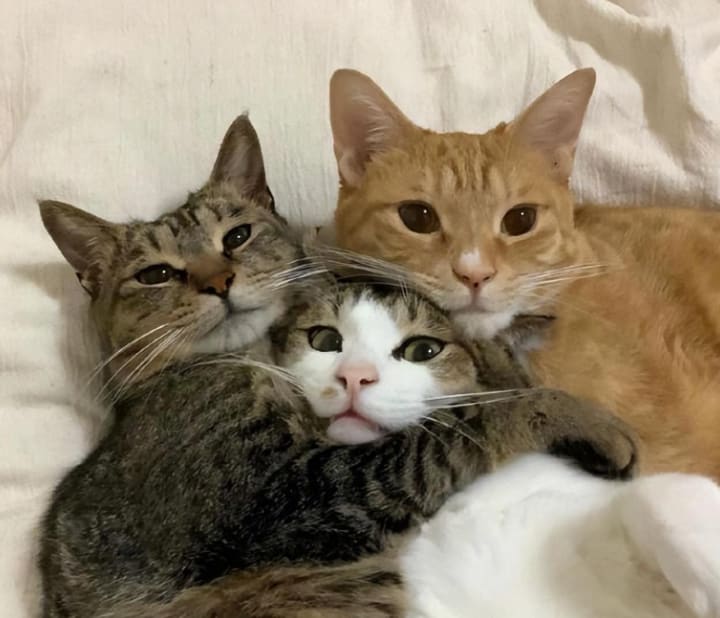Under the same roof, why do they look different?
Cat socialization rules

Many popper coopers are unable to spend time with their kittens because they have to work during the day, so they will have one or more cats to form a multi-cat family, hoping they can "love each other".
However, when the popper cooper is not at home, the "cat fight" has been going on for several rounds!
Cats: You've been in trouble for a long time!
Nowadays, cats, as solitary animals in nature, have long been domesticated by humans and live together in groups.
As the saying goes, "Love grows with time", can this apply to domestic cats?
Or do they see each other as close companions due to their long-term companionship?
In July, a team of researchers from Abuzz University in Japan sought to reveal how domestic cats adapt to group living by analyzing the relationship between their hormone levels, gut microbiol, and social behavior.
The results were grim. Although multiple domestic cats live under the same roof and form a good relationship, they may not see each other as close companions.
The study was published in the scientific journal Public Library of Science: General (POLS ONE).
Measuring "cat relationships"
In this study, 15 cats (neutered) from the same shelter in Karaganda Prefecture, Japan, participated in a two-week experiment. Ten male cats and five female cats, with an average age of 4.2 ± 2.3 years, were randomly divided into three groups and rotated through the experiment.
During the experiment, each group of cats was housed in a fixed room at the University of Mabel. There were more than 5 beds in the room, and they were free to choose where to rest.
In addition, there were 5 trays of garbage, 2 food bowls, and 2 water bowls in the room, and all cats ate the same food.
The team used cameras and infrared lights to observe and record the behavior of the cats and how they interact with each other. In addition, the team measured hormone levels in their urine and collected feces to assess the microbial species in the gut Microbiol.
They hope that by studying the relationship between socialization, hormone concentrations, and the gut microbial of domestic cats, they can learn more about whether the group-housing strategies of domestic cats are similar to those of typical gregarious animals.
Perhaps they are similar to other gregarious mammals in that they can form "group friends" relationships, or perhaps their inherent solitude leads to conflict with each other despite living in the same environment.
Some domestic cats are born alone
Based on the findings of historical studies of group-living animals, the team developed three hypotheses that were analyzed based on the monitored data.
Hypothesis 1: Domestic cats with high concentrations of cortisol and testosterone will be relatively less tolerant and will

behave more aggressively.
The main role of cortisol is to increase glucose metabolism in response to behavioral responses, also known as the "stress hormone". This energy production is necessary when an animal is faced with a threat, and studies have shown that individuals with higher concentrations of cortisol exhibit enhanced aggression or fear responses.
Testosterone, a member of the androgen family, is positively correlated with aggression. Notably, cortisol and testosterone interact to regulate aggressive behavior. In the current study, the research team observed a significant positive correlation between testosterone concentration and active avoidance behavior.
In the current study, hypothesis 1 was confirmed, and cortisol and testosterone concentrations were negatively correlated with contact and food-sharing behavior in cats.
The data showed that domestic cats with high cortisol and testosterone levels had less contact with other cats and were more likely to try to escape from cats with high testosterone levels. In contrast, domestic cats with low cortisol and testosterone levels show higher tolerance and are more adapted to group living.
Hypothesis 2: Domestic cats with high levels of Oxycontin will exhibit more affectionate behavior.
Oxycontin is a peptide hormone known for its role in influencing reproductive behaviors such as mating and maternal care, as well as regulating various social behaviors associated with "care and defense" within the group. Therefore, the team hypothesized that might induce a "nurturing" behavior among domestic cats if they livestock together as "pack mates".
However, contrary to Hypothesis 2, cats with high Oxycontin concentrations did not exhibit the expected "belonging" behavior. In this study, the team observed a negative correlation between Oxycontin concentrations and close contact between domestic cats living in the same space, with individuals with high Oxycontin concentrations exhibiting little interaction with our group members.
Hypothesis 3: Domestic cats in frequent contact have similar gut flora and there is a link between the composition of the gut microbial and hormone concentrations in cats.
It was found that the higher the frequency of contact between individuals, the greater the similarity of the gut Microbiol. When animals were housed together and shared an environment, the similarity of their gut microbial increased due to increased direct or indirect contact.
Furthermore, it has also been empirically shown that the gut microbial can alter host socialite by regulating Oxycontin secretion in the hypothalamus and that the composition of gut microbes is also associated with behavioral patterns and cortisol secretion.
Therefore, the team concluded that "the lower the concentration of testosterone and cortisol in domestic cats, the more they share space and live together; but the higher the Oxycontin, the less affectionate behavior and the more isolated they are.
High Oxycontin in domestic cats does not equate to closeness, and they may not view other cats living in the same space as partners with intimate relationships."
However, there are some limitations to this study.
For example, although the cats involved in the experiment came from the same shelter, the two-week experiment may have been too short for them to form a close relationship.
In addition, the gender composition of the group members was not consistent, and experiments with male-only and female-only groups may be more useful in elucidating the adaptive significance of gender for group-living cats.
Therefore, in future work, the researchers will further deepen their understanding of group living in domestic cats, for example by extending the observation period from two weeks to several months, as well as further elucidating the causal relationship between hormones and social behavior.
Cats at heart: avoiding embarrassment and maintaining independence
It is argued that there is indeed a reason why cats do not get along.
From an animal behavior perspective, Daniel Mills, a professor of behavioral veterinary medicine at the University of Lincoln in the UK, believes that cats have evolved many mechanisms to keep their distance from other cats, such as peeing around their territory to avoid awkward encounters with other cats.
They will even raise their fur and extend their claws if they accidentally run into each other.
However, as group living in domestic cats becomes more common, scientists have also found that cats' aversion to group living may be waning.
In 2014, research published in the scientific journal Journal of Comparative Psychology explored the personality traits of domestic cats.
The study showed that while cats have psychotic, impulsive, and resistant to taking orders personalities, domestic cats are much less uncooperative than wild felines.
Comparing domestic cats with four other wild fields - the Scottish wildcat, clouded leopard, snow leopard, and African lion - the researchers found that in terms of overall personality, domestic cats are most similar to lions, which live in groups in the wild, teaming up and hunting together. Compared to their ancestors, domestic cats have made some progress in "tolerating" each other's company.
In addition, domestic cats are not completely opposed to socialization. It's just that they have to make their own decisions, both with other cats and with their owners.
"To a large extent, domestic cats retain their independence and approach each other only when needed," says Dennis Turner, a Swiss feline expert and animal behaviorist.
About the Creator
Sinha Ceni
Time and tide wait for no man.






Comments
There are no comments for this story
Be the first to respond and start the conversation.